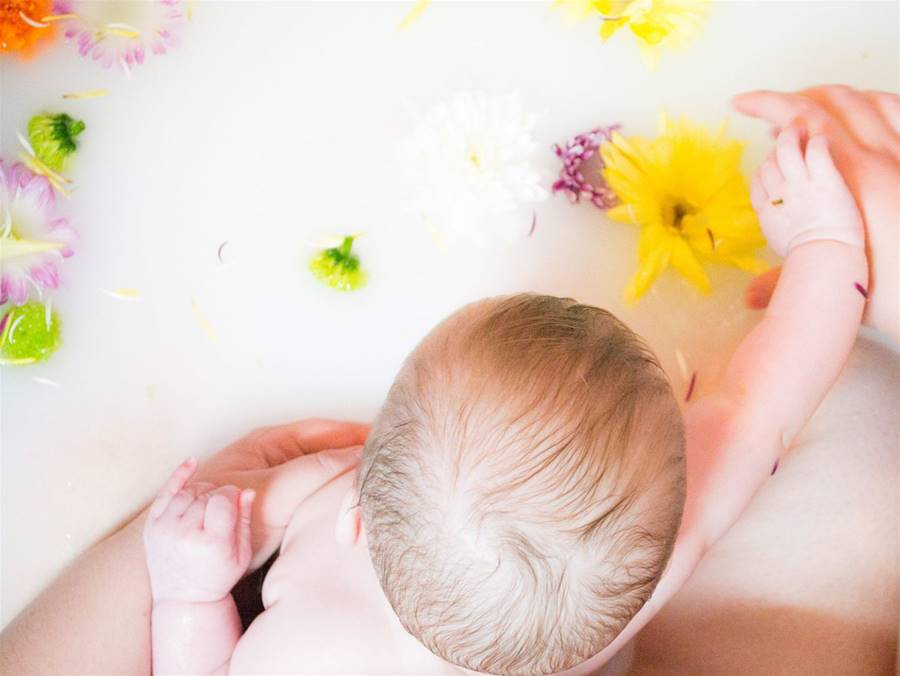


Chest- and breastfeeding isn't the only way your baby can benefit from the healing powers of breast milk. Giving your baby a breast milk bath has long been a popular (and all-natural way) for soothing common skin issues ranging from dryness and to acne and eczema.
Don't worry—we're not suggesting that you dunk your babe in a tub filled to the brim with breast milk. You'll only need a little bit of pumped breast milk to into a soothing, spa-like experience. That's really all it takes because human breast milk is positively packed with anti-inflammatory and anti-bacterial properties.
Pediatrician Tanya Altmann, MD, and author of the American Academy of Pediatrics books and notes that breast milk contains many ingredients found in —including fat, protein, carbohydrates, vitamins, and minerals.
"It's not surprising that it could be beneficial for skin," Dr. Altmann says. "Antibodies contained in breast milk can also help with many minor skin irritations and infections. That's the rationale behind putting a drop or two of breast milk in the eye for minor irritation or infection, or for baby acne or a diaper rash. It often helps!"
It may seem obvious, but breast milk baths are exactly what they sound like: they are baths comprised of water and breast milk.
While the benefits of breast milk are widely touted and well known, Dr. Altmann notes that there's actually minimal research to back up breast milk baths. A showed that breast milk was as effective as hydrocortisone 1% at treating mild to moderate eczema, and a did find that breast milk can successfully be used to treat a variety of skin ailments, including dry skin, diaper rash, acne, and even umbilical cord care.
Still, breast milk baths has been used by many to treat and prevent common skin issues in babies including:
Dry skin
Baby acne
Minor cuts
Cradle cap
Breast milk can also be used to clear blocked tear ducts and soothe sore, cracked nipples—in chest- and breastfeeding parents.
Giving your baby a DIY breast milk bath is as easy as a giving them a regular, with the simple addition of a splash of breast milk. For her milk bath recipe, lactation consultant Polly Gannon recommends using about 150 to 350 milliliters of breast milk—just enough to make the water look cloudy or milky.
"Don't use too much milk, otherwise it'll cause the baby to smell milky," Gannon warns.
You can use fresh, stored breast milk, or even milk that was left out in error for a milk bath, but frozen breast milk should be thawed before adding it to the warm bath water. Once the milk is ready, follow these steps to give baby a milk bath:
Add the breastmilk to a baby bathtub filled with warm water.Gently place baby in the tub and allow them to soak for about 15 minutes. Use your hands to sprinkle water all over baby, paying special attention to any irritated areas.When you're done, no need to rinse baby.
Simply take them out of the bath and gently pat them dry.Apply fragrance-free lotion to baby's skin to lock in the hydrating benefits of the milk bath.
If all goes well, you could see an improvement in your child's skin following their breast milk bath, but do keep a close eye on any irritation that may require additional treatment. "I can't see any danger to adding breast milk to your infant's bath," Dr. Altmann says, "but it's always a good idea to talk to your own pediatrician if your infant has any skin rashes or irritation not improving."
While the benefits of breast milk baths are not well understood—they have not been well researched nor are they well known—anecdotally, many parents have seen amazing results.
There is also little to no risk. As such, if your baby is experiencing a skin condition, you may want to try giving them a breast milk bath. It could help soothe their discomfort and alleviate their symptoms. A real win-win.

